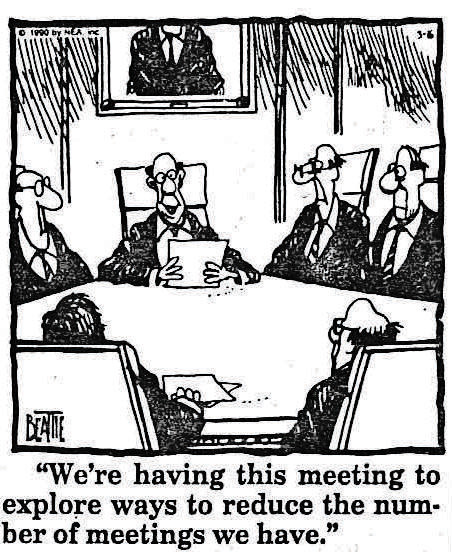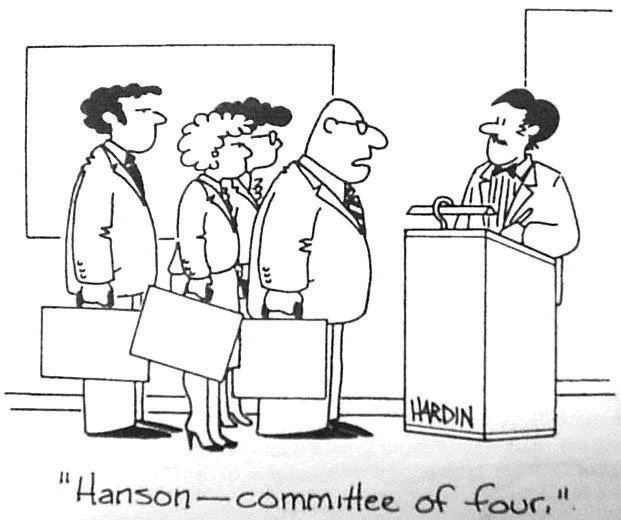12.1: Planning a Meeting
- Page ID
- 58767
Whether and how carefully you plan any undertaking will determine in large part how well it turns out. Bad planning makes it harder to achieve your goals; good planning makes it easier. This certainly applies to meetings of groups, so it’s wise for us to examine how to plan those meetings effectively. Before we consider the ins and outs of that planning, however, let’s reflect on the proper role of meetings.
What Are Meetings for?
Office equipment and supplies constitute tools to support the work of most modern groups such as student teams in college classes, employees and executives in businesses, and collections of people in other organizations. None of those groups would say, however, that using copy machines and staplers is one of their goals. And none of them would visit a copy machine unless they had something they needed to reproduce. They wouldn’t grab a stapler, either, unless they had some papers to attach to each other.

Meetings resemble office supplies in at least one way: they can help a group accomplish its goals. But meetings are like office supplies in another way, too: they’re only a means toward reaching group goals, not an end in themselves. And sometimes they’re even antithetical to the efficient functioning of a group. One statistical analysis of workers’ reactions to meetings discovered a significant positive relationship between the number of meetings attended and both the level of fatigue and the sensation of being subjected to a heavy workload. Luong, A., & Rogelberg, S.G. (2005). Meetings and more meetings: The relationship between meeting load and the daily well-being of employees. Group Dynamics: Theory, Research, and Practice, 9(1), 58–67.
Remember these truths, therefore: If it is operating well, your group at some point probably adopted goals for itself. It may even have ranked those goals in order of importance. Members of a student team might, for example, decide that their joint goals are to earn a high grade on their group project, to have fun together, and to ensure that all of them can secure a positive recommendation from the instructor when they look for a job after graduation.
“To meet” is not one of the goals of any group, though, is it? No; your goals involve doing things, not meeting—not even meeting to decide what you’re going to do and whether you’re doing it. Therefore, you should not meet until and unless doing so will clearly contribute to a real goal of your group.
What this means in practical reality is that many, many regularly-scheduled meetings probably ought to be canceled, postponed, or at the very least substantially shortened. It means that meetings which aren’t part of an official, ongoing series should be conducted only if the people who would be participating agree that having the meetings is necessary to answer a question, solve a problem, make a decision, or ensure that people know what it is they are and should be doing. It means, in short, that a group’s “default position” should be never to meet.
If you’re in a position to decide whether and when a meeting will take place, you’re in control of what some might consider other people’s most valuable possession: their time. If you take this responsibility seriously and act on it wisely, your fellow group members will appreciate it—especially since many group leaders don’t do so.
To Meet or Not to Meet
In the twenty-first century, technology offers techniques for accomplishing many group goals without meeting face to face. A helpful website called “Lifehacker”www.lifehack.org/articles/productivity/kill-meetings-to-get-more-done.html suggests that you follow these steps before scheduling in-person meetings:
Get done what you can by email. If email doesn’t accomplish your aims, use the telephone. Only if neither email nor the phone works should you meet face to face.
Calculate the opportunity cost of a potential meeting. What task(s) that you could be engaged in at the time of the meeting will you have to postpone, or forgo entirely, because of the meeting? Is it worth it?
Ask yourself what bad results, if any, will come to pass if you don’t meet. What about if you don’t meet this time, but later instead? If the bad things which you expect to arise if you don’t meet are minimal or can be dealt with easily, don’t meet, or at least not now.
Ask if it’s essential for everyone in the group to be at the same physical location at the time of the meeting. Assess whether the chore of just moving people’s molecules from one place to another could render a face-to-face meeting undesirable.
If It’s “to Meet,” Then What?
Once you’ve decided that you should hold a meeting of some sort, you should do your best to make sure it will run well. Part of this undertaking is to ensure that all the members of your group understand the significance of the time they’ll be devoting to getting together. To this end, you may want to create a list of basic obligations you feel everyone should fulfill with respect to all meetings. These obligations might include the following items:
Guidelines for Planning a Meeting
Again, first of all: don’t meet at all unless you need to. Once you’ve determined that a meeting will promote rather than hinder productivity, preparing for it well will give you a head start on maximizing its effectiveness. Here are six guidelines to take into account as you plan a meeting:
Identify the Specific Goals
Identify the specific goals you plan to achieve in the meeting and the methods you’ll use to decide if you’ve achieved them. Write the goals down. Reread them. Let them sit awhile. Read them again to see if they’re still appropriate and necessary.
If the goals of the meeting still look as though they’re all valuable, remember Dwight Eisenhower’s dictum that “What is important is seldom urgent, and what is urgent is seldom important http://www.mindtools.com/pages/article/newHTE_91.htm.” If you’re not sure you can get everything done that you hope to in the time you’ll have available, set priorities so that the most urgent items are taken care of quickly and you can postpone others without endangering what’s most important to get done.
Decide Carefully Who Needs to Attend
At one point, Amazon Corporation implemented a “two-pizza guideline” whereby it limited the number of people who composed its teams to the quantity that could be fed with two pizzashttp://www.fastcompany.com/50106/inside-mind-jeff-bezos. If you calculate that the people you plan to invite to your meeting constitute larger than a two-pizza group, ask yourself if all of them really, really, really need to be there.
Produce a Clear, Brief, Thorough, Informative Agenda

Don’t spring surprises on people. To give them a solid idea of what to expect, divide the meeting’s agenda into simple categories: for instance, the establishment of a quorum; approval of minutes and the agenda; officers’ and (sub)committee reports; unfinished business; new business, and “other.” For each item, name the individual in charge of it, indicate whether it will require action by the group, and provide an estimated duration. (You’ll need to confirm these estimates with the responsible parties, of course). If you expect some or all of the group’s members to complete a task before they arrive, such as reading a report or generating possible solutions to a problem, tell them so clearly.
Here’s a special note, too: Don’t plan to stretch the contents of a meeting to fit a preordained time. Strive to cut down on how long you spend to handle each item on your agenda as much as you can so that members of your group can get back to their other responsibilities as soon as possible. A shorter-than-expected meeting is usually a thing of joy.
Pick a Good Venue
If you have a choice, plan to gather in a place with plenty of light, comfortable furniture, and a minimum of distracting sounds or sights. You should be able to adjust the temperature, too, if people get too hot or cold. Make sure that any technological tools you think will be available to you are actually going to be on hand when you meet and that they’re all functioning. Even if you expect to have access to a laptop computer and a projector, plan to bring a flip chart and markers so that people will be able to express and record ideas spontaneously during the meeting. And all other things being equal, find a place to meet regularly which is large enough and secure enough to allow your group members to store the “tools of their trade” there—flipcharts, writing supplies, reference books, etc.—between gatherings.
Make Sure the Participants Receive the Agenda
Make sure people receive the agenda you’ve prepared in a timely fashion so they’ll know why, when, where, and for how long the group is expected to meet. Two reminders per meeting may be enough—one by letter and one by e-mail, for instance—but three are better, including one the day before the meeting itself. Free computer-based confidential text-messaging services such as Class Parrot (classparrot.com/) and kikutext (kikutext.com/) can provide another channel for reaching group members.
One college president from a Southern state maintained that he’d gotten his board of trustees to act “like trained seals,” partly through thorough preparation for their meetings. In fact, the president actually ran practice meetings with the board to make sure there would be no surprises when the real meetings took place. You should practice, too, at gently, repeatedly, and clearly notifying other group members of the time and agenda of each meeting. For every person who thinks you’re being repetitive, two or three will thank you for keeping them from overlooking the meeting.
If you’re planning to meet in a place for the first time, or if you’re expecting someone to attend your meeting for the first time, be sure to provide clear and complete directions to the location. With online tools such as mapquest.com and google maps at your disposal, it should cost you very little time to locate such directions and send them to members of your group.
Arrive Early
Arrive early to size up and set up the place where you’re meeting. Rooms sometimes get double-booked, furniture sometimes gets rearranged, technological tools such as LCD projectors and laptop computers sometimes break down or get taken away to be repaired, and so on and on. If you’re the person in charge of leading the meeting, you need to know first if unexpected happenings like these have taken place.

Following these half-dozen guidelines won’t guarantee that your meetings will be as successful as you wish them to be. If you don’t heed them, however, you’re apt to encounter considerable difficulty in achieving that aim.


